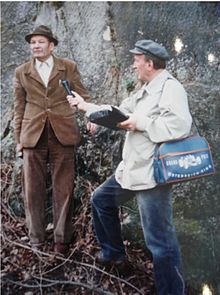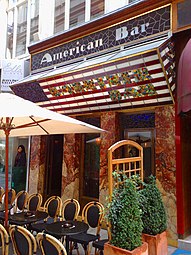Friedrich sacrificial cow

Friedrich Sacrificial Cow (born May 1, 1923 in Mannersdorf am Leithagebirge , Lower Austria ; † April 20, 1993 in Eisenstadt , Burgenland ) was an Austrian master stonemason and sculptor .
Live and act
Friedrich was born into a stonemason family. His parents were Karl Opferkuh, a stonemason in Mannersdorf and Maria, geb. Tatzber from Sommerein . The grandparents of the stonemasons Johann Opferkuh and Maria, geb. Zwirschitz. Friedrich learned the stonemason trade from 1937 to 1940 at the Eduard Hauser company , the oldest industrial stonemason company in Vienna with quarries in Mannersdorf. His grandfather and father had already worked there as foremen . As a journeyman , he was involved in the reconstruction of the Burgtheater and the State Opera after the Second World War . From 1947 he attended the building trade school in Hallein with the main subject stone technology in the winter months .
The first master of his family
Friedrich Opferkuh became the first master in his family and in 1951 opened his own stonecutter and quarry in Mannersdorf. He married Theresia Rebsch, son Friedrich († July 12, 2015) and daughter Marianne (married Kruckenfellner, † April 11, 2002) were born. When Theresia died in 1970, Leopoldine Windholz became his second wife, with whom he remained connected to the end. His scope of work extended from Eisenstadt, Podersdorf, Illmitz, Neusiedl am See, Hainburg, Marchegg, Klosterneuburg to Vienna. Major orders from Vienna included restorations in the Schotten , Minoriten and Michaelerkirche as well as in the Palais Daun-Kinsky , Liechtenstein and Ferstel . An exclusive example was the famous Viennese "Loos-Bar" ( American Bar ), where sacrificial cow repaired a wall made of rare onyx , among other things .
The "Palais Ferstel"
In 1971, the President of the Federal Monuments Office, Walter Frodl , dealt with the bank and stock exchange building in Vienna, which was badly damaged by the war. Otto Casensky's office for technical geology prepared an expert opinion on the natural stone facade . A balcony made of hard imperial stone was attached to the facade of Freyung 2 over the entire 15.4 m long front . This balcony was no longer available and the remains of the step plates and the supporting brackets were barely visible on the facade . In July 1975 the balcony was reconstructed and master stonemason Friedrich Opferkuh from Mannersdorf am Leithagebirge was commissioned to restore the old condition - made of Mannersdorfer stone, reinforced concrete and artificial stone .
Consultant of the Federal Monuments Office
Elias Hügel , court stone cutter under Charles VI. and church builder in the imperial quarry in the first half of the 18th century, was and is the most important master of the Leithagebirge across the ages. 240 years later, after the Second World War , there was again a master in Mannersdorf, Friedrich Opferkuh, who broke all the limitations of a craftsman, developed into a renaissance man in his diversity , and became the teacher of future university professors. With his extraordinary knowledge and skills, he was highly respected far beyond the Leithagebirge region, especially at the Federal Monuments Office in Vienna, and was called in as a consultant , especially for the planned revitalization of Schloss Neugebauten . His admirers also call it "Elias Hill of the 20th Century".
Tower of Babel , work on the stone
Founder of the Mannersdorfer Museum
As chairman of the Mannersdorf cultural and museum association, he founded a museum in 1979, in which he set up a stonemasonry department in 1987. This “stone technology department”, which emerged from his private collection, was looked after by him and constantly increased due to his constant collector's passion, keeps a large number of mostly original historical stone working tools and is an important collection for friends of the stone carving art.
A local museum was planned for the 400th anniversary of Kaisersteinbruch in June 1990 (state of knowledge at the time). Master sacrificial cow supported the efforts of the teacher Helmuth Furch, became one of the main initiators and laid the foundation for the future stonemason museum Kaisersteinbruch .
Stone talks
As the culmination of his life's work, he considered his treatise on the art of stonemasonry , which is kept in an unbound form in the Steinmetzmuseum Kaisersteinbruch. From this the "Stone Conversations": ... before the stonemason begins to work on a stone, he first observes it carefully. The qualities and defects of the blank are weighed against each other, one thinks about how to get the best out of the stone. This examination and reflection is different every time, just as there are never two stones of the same kind - it can start a real self-talk .
One begins to think: .. there is a lasse, there is a crack, but fortunately it is not particularly long .. here it sounds good, but there it is bad again, there is something rattling .. there it goes well "from the stuff" , it's rather soft and stubborn .. I don't open the camp there .. It's better there. Sometimes stonemasons also talk to their stones, which is easier to understand when you know the enormous effort with which a workpiece is created .
Friedrich Opferkuh wrote the foreword to the "Hügel-Buch" in 1992: He was not only a practical master of his subject, but also a master in design and construction. Various churches were built by him ... The altars in Kaisersteinbruch are witnesses. The harmony of the structure and the spirit of the profiles show a feeling for dimensions. An unknown world. Because only those who have worked themselves can handle structures properly. At the Kaisersteinbrucher altars you can see every blow. A processing landscape that is no longer often seen today. This makes a teaching example for stone processing.
Desolate monastery of Kaisersteinbruch
Master sacrificial cow recognized and studied the historical significance of the desolate monastery on the military training area of Kaisersteinbruch, was able to read in the soil forms and faults like in a book and brought the "buried" back into the consciousness of some people. With the Museum and Cultural Association Kaisersteinbruch he wanted to get a sign with a plaque, on November 2, 1990 a meeting took place with the commandant Colonel Alfred Petznek on the spot. This request was rejected for military reasons. Years later these scanty remains had completely disappeared.
Honors
- In 1978 the Federal Minister for Science and Research, Hertha Firnberg , appointed him honorary correspondent for the Federal Monuments Office.
- 1983 Ring of Honor of the municipality of Mannersdorf am Leithagebirge, thanks and recognition from the district authority of Bruck an der Leitha.
- 1987 Silver badge of honor from the Federal Guild of Stonemasons, Silver Badge of Honor from the Natural History Museum in Vienna.
Sculptor Alfred Hrdlicka
The Kaisersteinbrucher Symposium, chairman Helmuth Furch, asked the sculptor Alfred Hrdlicka in a letter dated April 13, 1993 ... ... I would now ask you to give this year's symposium a special accent and to ask us, a group of approx To enable people to talk to you and “watch” in the master class . In the Hilger Gallery , June 3, 1993 was suggested, that would be ideal.
Master stonemason Friedrich Opferkuh from Mannersdorf - he founded a museum of stonemasonry there years ago - will be 70 years old in May. Not to celebrate, but: from some conversations with him I know that he would like to get to know you very much. Master sacrificial cow, THE stonemason of the Leithagebirge, has "made the stones alive, speaking," for me.
Friedrich Sacrificial Cow Symposium
The museum and cultural association Kaisersteinbruch gave the symposium its name in gratitude after his death in 1993. Ferenc Gyurcsek from Budapest restored the “Kuruzzenkreuz” , a plague cross from 1646, the transport from the Blauer Bruch in the military training area to the future location was organized by master sacrificial cow. Alexandru Ciutureanu from Bucharest made a halo of lime wood for the high altar of the Kaisersteinbruch Church.
The stonemason's mark of master sacrificial cow is chiseled on the Kaisersteinbruch local stone by the sculptor Alexandru Ciutureanu .
author
- Stonemason technology in the Museum Mannersdorf am Leithagebirge , Verlag Kultur- und Museumsverein Mannersdorf 1992.
- Forming the stone and tools from ancient times to today. Mannersdorf 1993, typewritten copy.
literature
- Preservation of monuments in Lower Austria: handicrafts, the tools of the stonemason. Friedrich sacrificial cow. In: Messages. No. 2, 1990.
- Helmuth Furch : Elias Hügel, court stone mason (1681–1755). Foreword by Friedrich Sacrificial Cow, 1992. ISBN 978-3-9504555-2-6 .
- Elfriede Hanak: Lower Austria . Traditional craft in examples. In: stone masons. 1995, pp. 185-188.
- Sacrificial cow Friedrich. In: Felix Czeike : Historisches Lexikon Wien. 4th volume. 1995, p. 454.
- Helmuth Furch: In: Messages of the Museum and Culture Association Kaisersteinbruch . ISBN 978-3-9504555-3-3 .
- The honorable and artful Mr. Friedrich Opferkuh, master stonemason in Mannersdorf, has died. No. 26, 1993.
- Friedrich Sacrificial Cow, master stonemason at Leithaberg (1923–1993). Festschrift. No. 50, 1998. With contributions by Franz Bamberger, Österr. Federal guild master for stonemasons; Dr. Andreas Rohatsch Engineering Geology TU Vienna, Manfred Kandler , Austrian Archaeological Institute .
- Helmuth Furch, Historical Lexicon Kaisersteinbruch . 2 volumes. Museum and cultural association, Kaisersteinbruch 2002–2004. ISBN 978-3-9504555-8-8 .
Web links
- Helmuth Furch, Friedrich Sacrificial Cow 1993, 1998
- Lisl Waltner : "Historical stone carving - elaboration of a cornice piece with return" (1988). in the online archive of the Austrian Media Library (ÖWF film with Friedrich Opferkuh; 22:10 min.)
Individual evidence
- ^ "Austrian Journal for Art and Monument Preservation" , 1971, issue 1/2
- ^ Photo archive of the Federal Monuments Office
- ↑ Data from the culture and museum association Mannersdorf a. Lgb. 1993
- ^ Helmuth Furch, Historisches Lexikon Kaisersteinbruch . 2 volumes, 2002–2004. Museum and cultural association, Kaisersteinbruch 1993 .
- ↑ Hans Schwengersbauer: Kaisersteinbruch, former Amelin quarry "Blauer Bruch". - Documents for the excursions of the 7th Annual Meeting of the Austrian Palaeontological Society, 12. – 14. October 2001, Mannersdorf am Leithagebirge
| personal data | |
|---|---|
| SURNAME | Sacrificial cow, Friedrich |
| BRIEF DESCRIPTION | Austrian master stonemason and sculptor |
| DATE OF BIRTH | May 1, 1923 |
| PLACE OF BIRTH | Mannersdorf am Leithagebirge , Lower Austria |
| DATE OF DEATH | April 20, 1993 |
| Place of death | Eisenstadt , Burgenland |










